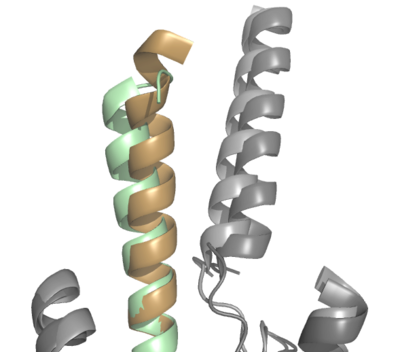User:Nathan Marohn/Sandbox 2
From Proteopedia
(Difference between revisions)
| Line 7: | Line 7: | ||
When the <scene name='10/1043643/Overview_gip_gip-r/1'>GIP ligand binds to the receptor</scene>, a GPCR pathway is activated, initiating a cascade of enzymes<ref name="Mayendraraj"/>. After binding to GIP, GIP-R undergoes a conformational change that allows the G-alpha subunit to dissociate from the GPCR and travel down the phospholipid bilayer. A palmitic fatty acid keeps the G-alpha subunit tightly bound to the lipid bilayer as it travels to the target enzyme, adenylyl cyclase. The phosphorylation of adenylyl cyclase produces the second messenger, [https://en.wikipedia.org/wiki/Cyclic_adenosine_monophosphate cyclic adenosine monophosphate], (cAMP). cAMP then activates the second enzyme, [https://en.wikipedia.org/wiki/Protein_kinase_A Protein Kinase A], (PKA), which inhibits potassium channels and activates calcium channels, causing an influx of Ca2+ ions into the cell. PKA also activates a transcription factor (CREB)<ref name="Dalle"/> that promotes insulin release from the cell. The release of insulin into the bloodstream promotes the uptake of circulatory glucose into target tissues. | When the <scene name='10/1043643/Overview_gip_gip-r/1'>GIP ligand binds to the receptor</scene>, a GPCR pathway is activated, initiating a cascade of enzymes<ref name="Mayendraraj"/>. After binding to GIP, GIP-R undergoes a conformational change that allows the G-alpha subunit to dissociate from the GPCR and travel down the phospholipid bilayer. A palmitic fatty acid keeps the G-alpha subunit tightly bound to the lipid bilayer as it travels to the target enzyme, adenylyl cyclase. The phosphorylation of adenylyl cyclase produces the second messenger, [https://en.wikipedia.org/wiki/Cyclic_adenosine_monophosphate cyclic adenosine monophosphate], (cAMP). cAMP then activates the second enzyme, [https://en.wikipedia.org/wiki/Protein_kinase_A Protein Kinase A], (PKA), which inhibits potassium channels and activates calcium channels, causing an influx of Ca2+ ions into the cell. PKA also activates a transcription factor (CREB)<ref name="Dalle"/> that promotes insulin release from the cell. The release of insulin into the bloodstream promotes the uptake of circulatory glucose into target tissues. | ||
| - | GIP-R plays a key role in mitigating Type II diabetes symptoms by promoting both weight loss and insulin secretion. [https://en.wikipedia.org/wiki/Type_2_diabetes Type II diabetes], or insulin resistance, is caused by two variables: a decrease in insulin-sensitive cell responses and insulin secretion from beta cells. Without adequate insulin secretion, cellular glucose uptake is diminished and blood glucose levels remain unhealthily high. Excess blood glucose is stored in the liver as glycogen, which is converted to fatty acids in adipose tissue. By reducing blood glucose levels, GIP-R acts to reduce excess storage of fat. GIP-R can be activated by either the natural ligand, GIP, or a synthetic agonist, such as Tirzepatide. Tirzepatide binds to both GIP-R and [https://en.wikipedia.org/wiki/Glucagon-like_peptide-1_receptor GLP-R] (a GPCR with similar functionality). By binding to both receptors, Tirzepatide results in greater signal transduction, thus, a higher yield of insulin secretion. | + | GIP-R plays a key role in mitigating Type II diabetes symptoms by promoting both weight loss and insulin secretion<ref name="Seino"/>. [https://en.wikipedia.org/wiki/Type_2_diabetes Type II diabetes], or insulin resistance, is caused by two variables: a decrease in insulin-sensitive cell responses and insulin secretion from beta cells. Without adequate insulin secretion, cellular glucose uptake is diminished and blood glucose levels remain unhealthily high. Excess blood glucose is stored in the liver as glycogen, which is converted to fatty acids in adipose tissue. By reducing blood glucose levels, GIP-R acts to reduce excess storage of fat. GIP-R can be activated by either the natural ligand, GIP, or a synthetic agonist, such as Tirzepatide. Tirzepatide binds to both GIP-R and [https://en.wikipedia.org/wiki/Glucagon-like_peptide-1_receptor GLP-R] (a GPCR with similar functionality). By binding to both receptors, Tirzepatide results in greater signal transduction, thus, a higher yield of insulin secretion. |
== Ligands == | == Ligands == | ||
Revision as of 21:16, 28 April 2024
Glucose-dependent insulinotropic polypeptide receptor (GIP-R)
| |||||||||||
References
- ↑ 1.0 1.1 Mayendraraj A, Rosenkilde MM, Gasbjerg LS. GLP-1 and GIP receptor signaling in beta cells interactions and co-stimulation. Peptides. 2022 May;151:170749. PMID:35065096 doi:10.1016/j.peptides.2022.170749
- ↑ 2.0 2.1 Dalle S, Quoyer J, Varin E, Costes S. Roles and regulation of the transcription factor CREB in pancreatic β -cells. Curr Mol Pharmacol. 2011 Nov;4(3):187-95. PMID:21488836 doi:10.2174/1874467211104030187
- ↑ 3.0 3.1 Seino Y, Fukushima M, Yabe D. GIP and GLP-1, the two incretin hormones: Similarities and differences. J Diabetes Investig. 2010 Apr 22;1(1-2):8-23. PMID:24843404 doi:10.1111/j.2040-1124.2010.00022.x
- ↑ 4.0 4.1 4.2 4.3 4.4 Sun B, Willard FS, Feng D, Alsina-Fernandez J, Chen Q, Vieth M, Ho JD, Showalter AD, Stutsman C, Ding L, Suter TM, Dunbar JD, Carpenter JW, Mohammed FA, Aihara E, Brown RA, Bueno AB, Emmerson PJ, Moyers JS, Kobilka TS, Coghlan MP, Kobilka BK, Sloop KW. Structural determinants of dual incretin receptor agonism by tirzepatide. Proc Natl Acad Sci U S A. 2022 Mar 29;119(13):e2116506119. PMID:35333651 doi:10.1073/pnas.2116506119
- ↑ 5.0 5.1 5.2 5.3 Zhao F, Zhou Q, Cong Z, Hang K, Zou X, Zhang C, Chen Y, Dai A, Liang A, Ming Q, Wang M, Chen LN, Xu P, Chang R, Feng W, Xia T, Zhang Y, Wu B, Yang D, Zhao L, Xu HE, Wang MW. Structural insights into multiplexed pharmacological actions of tirzepatide and peptide 20 at the GIP, GLP-1 or glucagon receptors. Nat Commun. 2022 Feb 25;13(1):1057. PMID:35217653 doi:10.1038/s41467-022-28683-0
- ↑ Yaqub T, Tikhonova IG, Lättig J, Magnan R, Laval M, Escrieut C, Boulègue C, Hewage C, Fourmy D. Identification of determinants of glucose-dependent insulinotropic polypeptide receptor that interact with N-terminal biologically active region of the natural ligand. Mol Pharmacol. 2010 Apr;77(4):547-58. PMID:20061446 doi:10.1124/mol.109.060111


